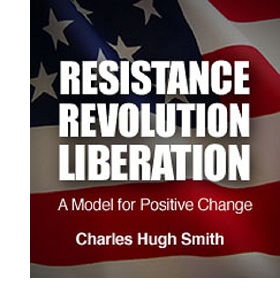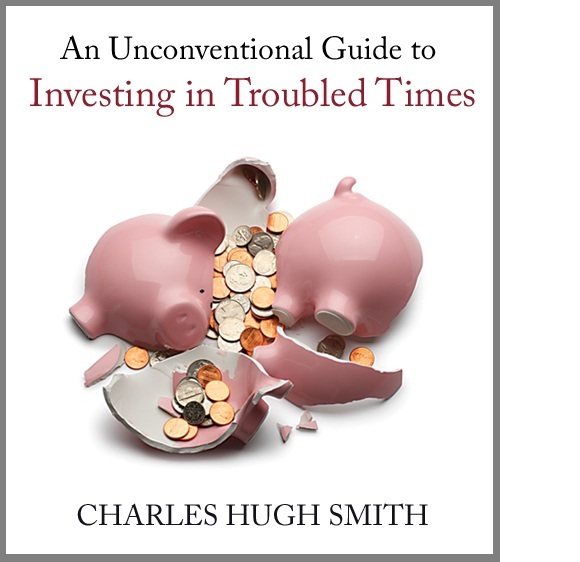

|

|
|||||||||||||
|
The E.U., Neofeudalism and the Neocolonial-Financialization Model (May 24, 2012) To fully understand the Eurozone's financial-debt crisis, we must dig through the artifice, obfuscation and propaganda to the real dynamics of Europe's "new feudalism," the Neocolonial-Financialization Model. Forget "austerity"and political theater--the only way to truly comprehend the Eurozone is to understand the Neocolonial-Financialization Model, as that's the key dynamic of the Eurozone. In the old model of Colonialism, the colonizing power conquered or co-opted the Power Elites of the region, and proceeded to exploit the new colony's resources and labor to enrich the "center," i.e. the home empire. In Neocolonialism, the forces of financialization (debt and leverage controlled by State-approved banking cartels) are used to indenture the local Elites and populace to the banking center: the peripheral "colonials" borrow money to buy the finished goods sold by the "core," doubly enriching the center with 1) interest and the transactional "skim" of financializing assets such as real estate, and 2) the profits made selling goods to the debtors. In essence, the "core" nations of the E.U. colonized the "peripheral" nations via the financializing euro, which enabled a massive expansion of debt and consumption in the periphery. The banks and exporters of the "core" countries exacted enormous profits from this expansion of debt and consumption. Now that the financialization scheme of the euro has run its course, the periphery's neofeudal standing is starkly revealed: the assets and income of the periphery are flowing to the Core as interest on the private and sovereign debts that are owed to the Core countries' commercial and central banks. This is the perfection of Neofeudalism. The peripheral nations of the E.U. are effectively neocolonial debtors of the Core countries' banks, and the taxpayers of the Core nations are now feudal serfs whose labor is devoted to making good on any bank loans to the periphery that go bad. To fully understand the Neocolonial-Financialization Model, we need to establish some basic characteristics of the Eurozone system. Do to that, let's start with the Eurozone and the euro. The European Union established a single currency and trading zone for the classical Capitalist benefits this offered: a reduction in the cost of conducting business between the member nations and a freer flow of capital and labor. From a Neoliberal Capitalist perspective, such a union consolidated power in a Central State proxy (The E.U.) and provided large State-approved cartels and quasi-monopolies easier access to new markets. From the point of view of the citizenry, it offered the benefit of breaking down barriers to employment in other Eurozone nations. On the face of it, it was a “win-win” structure for everyone, with the only downside being a sentimental loss of national currencies. But there was a flaw in the structure that is now painfully apparent. The Union consolidated power over the shared currency (euro) and trade but not over the member states’ current-account (trade) deficits and budget deficits. While lip-service was paid to fiscal rectitude via caps on deficit spending, in the real world there were no meaningful controls on the creation of private or state credit or on sovereign borrowing and spending. Thus the expansion of the united economy via the classical Capitalist advantages of freely flowing capital and labor were piggy-backed on the expansion of credit enabled by the Neoliberal Capitalist structure of the union. The alliance of the Central State and its intrinsic desire to centrally manage the economy to benefit its fiefdoms and Elites and classical free-market Capitalism has always been uneasy. On the surface, the E.U. squared the circle, enabling stability, plentiful credit creation and easier access to new markets for all. But beneath this beneficent surface lurked impossible-to-resist opportunities for exploitation and arbitrage. In effect, the importing nations within the union were given the solid credit ratings and expansive credit limits of their exporting cousins, Germany and France. In a real-world analogy, it’s as if a sibling prone to financing life’s expenses with credit was handed a no-limit credit card with a low interest rate, backed by a guarantee from a sober, cash-rich and credit-averse brother/sister. Needless to say, it is highly profitable for banks to expand lending to credit-worthy borrowers. Credit at very low rates of interest is treated as “free money,” for that’s what it is in essence. Recipients of free money quickly become dependent on that flow of credit to pay their expenses, which magically rise in tandem with the access to free money. Thus when access to free money is suddenly withdrawn, the recipient experiences the same painful withdrawal symptoms as a drug addict who goes cold turkey. Even worse--if that is possible--free money soon flows to malinvestments as fiscally sound investments are quickly cornered by State-cartel partnerships and favored quasi-monopolies. The malinvestments are masked by the asset bubble which inevitably results from massive quantities of free money seeking a speculative return. The E.U.’s implicit guarantee to mitigate any losses at the State-sanctioned large banks-- exemplifies the Neocolonial-Financialization Model. In effect, the big Eurozone banks “colonized” member states such as Ireland, following a blueprint similar to the debt-based one which has long been deployed in developing countries. This is a colonialism based on the financialization of the smaller economies to the benefit of the "core's" big banks and their partners, the Member States governments, which realize huge increases in tax revenues as credit-based assets bubbles expand. As with what we might call the Neoliberal Colonial Model (NCM) as practiced in the developing world, credit-poor economies are suddenly offered unlimited credit at very low or even negative interest rates. It is “an offer that’s too good to refuse” and the resultant explosion of private credit feeds what appears to be a “virtuous cycle” of rampant consumption and rapidly rising assets such as equities, land and housing. Essential to the appeal of this colonialist model is the broad-based access to credit: everyone and his sister can suddenly afford to speculate in housing, stocks, commodities, etc., and to live a consumption-based lifestyle that was once the exclusive preserve of the upper class and State Elites (in developing nations, often the same group of people). In the 19th century colonialist model, the immensely profitable consumables being marketed by global cartels were sugar (rum), tea, coffee and tobacco—all highly addictive, and all complementary: tea goes with sugar, and so on. (For more, please refer to Sidney Mintz’s book, Sweetness and Power: The Place of Sugar in Modern History). In the Neocolonial-Financialization Model, the addictive substance is credit and the speculative and consumerist fever it fosters. In the E.U., the opportunities to exploit captive markets were even better than those found abroad, for the simple reason that the E.U. itself stood ready to guarantee there would be no messy expropriations of capital by local authorities who decided to throw off the yokes of European capital colonization. The “too big to fail” Eurozone banks were offered a double bonanza by this implicit guarantee by the E.U. to make everything right: not only could they leverage to the hilt to fund a private housing and equities bubble, but they could loan virtually unlimited sums to the weaker sovereign states or their proxies. This led to over-consumption by the importing States and staggering profits for the TBTF Eurozone banks. And all the while, the citizens enjoyed the consumerist paradise of borrow and spend today, and pay the debts tomorrow. Tomorrow arrived, but the capital foundation of the principal—housing and the crippled budgets of post-bubble Member States—has eroded to the point of mass insolvency. Faced with rising interest rates resulting from the now inescapable heightened risk, the citizenry of the colonized states are rebelling against the loss of their credit-dependent lifestyles and against the steep costs of servicing their debts to the big Eurozone banks. Now the losses resulting from these excesses of rampant exploitation and colonization by the forces of financialization are being unmasked, and a blizzard of simulacrum reforms have been implemented, none of which address the underlying causes of this arbitrage, exploitation and financialization. Understood in this manner, it is clear there is no real difference between the monetary policies of the European Central Bank and the Federal Reserve: each seeks to preserve and protect the “too big to fail” banks which are integral to the Neoliberal State-cartel partnership. Both are attempting to rectify an intrinsically unstable private-capital/State arrangement-- profits are private but losses are public--by shoving the costs of the bad debt and rising interest rates onto the backs of the core-country taxpayers (now indentured serfs). The profits from the euro arbitrage and Neocolonial exploitation were private, but the costs are being borne by the taxpaying public of both core and periphery.
The Power Elites are attempting to set the serfs of the periphery against the serfs of
the Core, and this is necessary to keep both sets of serfs from realizing they are
equally indentured to the Core's pathological Financial Elite-State partnership.
 Resistance, Revolution, Liberation: A Model for Positive Change
(print $25)
Resistance, Revolution, Liberation: A Model for Positive Change
(print $25)
(Kindle eBook $9.95) Read the Introduction (2,600 words) and Chapter One (7,600 words) for free.
We are like passengers on the Titanic ten minutes after its fatal encounter with the iceberg: though our financial system seems unsinkable, its reliance on debt and financialization has already doomed it.

If this recession strikes you as different from previous downturns, you might
be interested in my book
An Unconventional Guide to Investing in Troubled Times (print edition)
or
Kindle ebook format. You can read the ebook on any
computer, smart phone, iPad, etc. Click here for links to Kindle apps and Chapter One.
The solution in one word: Localism.
Of Two Minds Kindle edition: Of Two Minds blog-Kindle

"This guy is THE leading visionary on reality.
He routinely discusses things which no one else has talked about, yet,
turn out to be quite relevant months later."
NOTE: gifts/contributions are acknowledged in the order received. Your name and email remain confidential and will not be given to any other individual, company or agency.
Or send him coins, stamps or quatloos via mail--please request P.O. Box address. Subscribers ($5/mo) and contributors of $50 or more this year will receive a weekly email of exclusive (though not necessarily coherent) musings and amusings. At readers' request, there is also a $10/month option. The "unsubscribe" link is for when you find the usual drivel here insufferable.
All content, HTML coding, format design, design elements and images copyright © 2012 Charles Hugh Smith, All rights reserved in all media, unless otherwise credited or noted. I would be honored if you linked this essay to your site, or printed a copy for your own use.
Terms of Service:
|
Add oftwominds.com to your reader:
My Big Island Girl
Instrumentals by my friend
|
| Survival+ | blog fiction/novels articles my hidden history books/films what's for dinner | home email me | ||